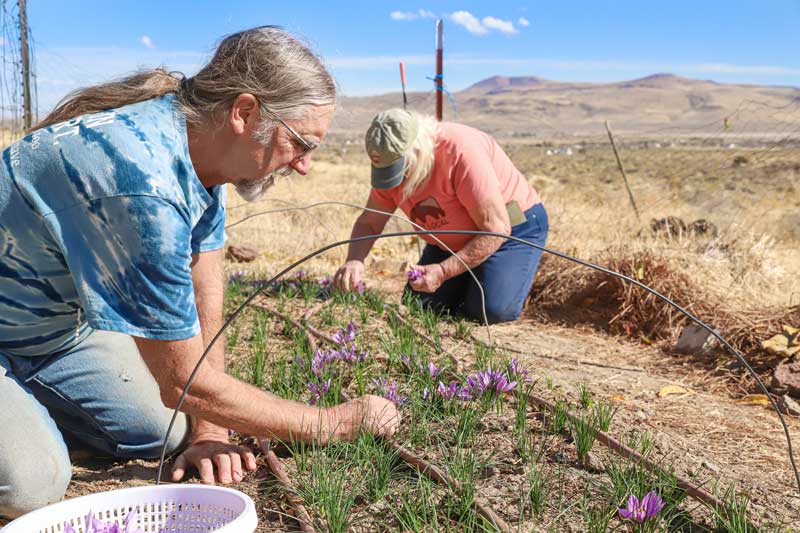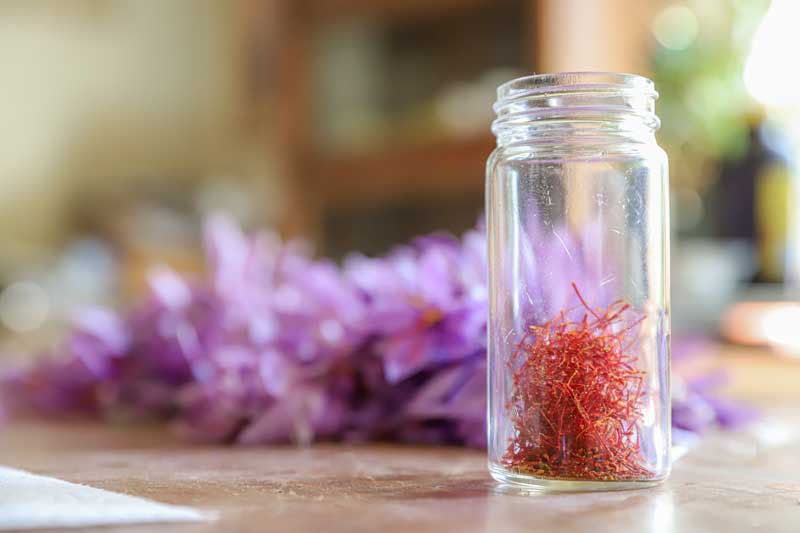Saffron adds brilliant color to fall gardens and exotic flavor to dishes.
The perfumed filaments of the Crocus sativus flower can fly away with the slightest breath. Yet their long history and extremely high value make them more substantial than their delicate nature would seem.
Grown in locations such as Iran, Spain, and Morocco, the scarlet spice saffron has been used as a flavoring, dye, and medicine for more than 3,500 years. Because saffron must be harvested by hand, it also is the most expensive spice in the world, at about $500 per ounce, and it takes more than 4,600 flowers to produce that ounce.
The tiny red threads are the dried female parts, or stigmas, of the saffron crocus. The amethyst-colored flowers grow from bulbs called corms, and the flowers offer their own autumn rewards. In the fall — when most flowers are turning brown and dying away — the crocuses, each one topped with three rosy crowns, open up to seek the sun.
Rich Soil, Wealthy Plant
Unlike other bulb plants, saffron crocuses are planted about six weeks before the first frost, lie dormant in the spring, send up green shoots in the summer, and then bloom in fall. The flowers are an October or November treat with their honey-like fragrance.
“They smell so beautiful,” says Marcia Litsinger of Churchill Butte Organics in Stagecoach.
Litsinger has grown saffron as a hobby for about 25 years and recently partnered with her friend, Pauline Hamilton, to grow the spice for profit. Litsinger previously lived near Tehran, Iran, and realized that saffron crocuses tend to do well at higher altitudes with a lot of protective mulch.
“The corms like to be dry in the summer, but our sun is so drying and kills anything in the soil unless you have it covered,” Litsinger says.
Litsinger mulches the dormant corms with about four inches of pine needles. She also amends her soil and puts chicken wire underneath the corms to protect them from squirrels and other ground-dwelling critters. Every three years, after the corms have exhausted the soil’s nutrients, Litsinger digs them up, divides them, and replants them in a new bed.

Steve and Marcia Litsinger pick saffron crocus flowers from the garden bed on their Churchill Butte Organics property in Dayton
Valarie Rider agrees that soil quality is essential for saffron corms. Her company, Heirloom Gardens in Reno, builds organic landscapes and forest gardens for clients in the Reno-Tahoe area, and she has planted saffron in her clients’ gardens. She says that soil areas that were not amended well don’t have good saffron crops. Rider has been building up the soil at her Midtown Reno home, and her saffron grows very well there — with a little assistance.
“They are more in need of good, rich soil than many other bulbs,” Rider says. “We have a deep wood mulch, which protects the soil from heave (the swelling of soil during freezing conditions) and keeps the plants from experiencing too much fluctuation in temperature.”
Rider recommends using soil rich in organic compost and at least three to four inches of deep mulch above the corms. She also recommends keeping the flowers in a location where you will notice them daily; they can bloom at different times, and it’s best to harvest the stigmas as quickly as possible.
“On the very first day that the flower opens, the stigmas pop out,” Rider says. “But if you wait, they are no good the next day. You have to go out daily with your tweezers.”
During harvesting, Litsinger uses tweezers and her fingers to carefully remove the three stigmas from each flower. She lays them out on paper towels and covers them with another paper towel to prevent the delicate strands from blowing away. After a few days, they are ready to store in a glass jar with a lid.
Saffron Support System
Marissa Ames, editorial assistant of Countryside Magazine, has been growing saffron in Fallon as an experimental cash crop for small villages in Africa. She works as an agricultural assistant for the nonprofit I Am Zambia, which teaches young boys and girls entrepreneurial and technical skills.
“I love eating saffron and I love cooking with saffron, so it just made sense to see if I could grow it,” Ames says. “Because saffron is so expensive and it’s grown primarily in Iran, people don’t realize that you can grow it just about anywhere. I grow it so I can instruct the right way to grow it in Zambia. It’s hard to give good instruction if you have not grown it yourself.”
Ames also experiments with saffron in the kitchen. She describes the spice as tasting “like bitter honey.” When making any Middle Eastern dishes, she throws a pinch of saffron into her rice cooker. She also has used saffron to flavor cheesecakes, ice cream, and her homemade goat’s milk butter.
“The hesitation to growing saffron is that it’s just not part of our culture,” Ames adds. “Learn about it and you’ll realize that it is so amazing and so easy to grow.”
Christina Nellemann is a writer and designer in Washoe Valley and is already getting a patch of soil ready for a few experimental saffron crocus corms.
Smoked Potato Appetizer with Saffron Aioli
(courtesy of Josh Deri and Whitney Reichman, chefs/owners, Blend Catering in Reno. Serves 10)

Deri recommends steeping saffron in liquids such as vinegar or broth rather than in fat. “The flavor comes out a lot better in a liquid,” he says. “Saffron also is very strong and potent, and a little goes a long way.”
2 pinches saffron
3 tablespoons sherry vinegar
20 small fingerling or baby potatoes
Pinch of salt (for potatoes)
2 egg yolks
1 teaspoon smoked paprika
1 teaspoon salt
1 teaspoon Dijon mustard
2 teaspoons honey
1 shallot, diced
3 cloves garlic, peeled
1½ cups olive oil
2 cups canola or grapeseed oil
Several slices Serrano ham or prosciutto
Chives, sliced
Steep saffron in sherry vinegar and set aside until ready to make aioli.
Place potatoes and pinch of salt in pot of cold water and bring to boil. Simmer potatoes on medium-low heat for about 15 minutes until they are cooked through. Remove potatoes from water and smash lightly with a spoon so they keep their round shape.
For the aioli, combine saffron-sherry mixture, egg yolks, smoked paprika, teaspoon of salt, Dijon mustard, honey, shallot, and garlic in blender or food processor and blend until smooth. With food processor or blender running on low speed, slowly drizzle in olive oil until aioli emulsifies and has consistency of mayonnaise.
Crisp potatoes: Heat canola or grapeseed oil in pan to 375 degrees F. Fry potatoes until dark golden brown. Season lightly with salt.
To assemble, add small amount of aioli atop each crispy potato, then top with piece of sliced ham or prosciutto and sliced chives.
Persian Lamb and Barley Soup
(courtesy of Marcia Litsinger, owner, Churchill Butte Organics in Stagecoach. Serves 4)
2 tablespoons vegetable oil
1 medium onion, chopped
4 to 5 cloves garlic, chopped
2 teaspoons turmeric
1 pound lamb neck bones or shanks
½ cup barley (soak in water for a few hours before using)
1 pinch saffron, soaked in hot (not boiling) water for a few minutes
2 tablespoons dried mint leaves
2 to 3 tablespoons apple cider vinegar
Salt and pepper, to taste
Squeeze of lemon juice, to taste
Greek yogurt, for topping
In heavy stock pot, sauté onion and garlic with turmeric in vegetable oil until soft. Brown lamb meat on high heat, then add enough water to cover meat. Reduce heat to low and cover. Once meat is cooked, remove it from bones, which you can discard. Add barley, saffron, and 2 cups water, and cook on medium heat. Once barley is cooked, add dried mint and vinegar, and allow to simmer at least 10 minutes. Add salt, pepper, and lemon juice to taste. Serve in a bowl with a dollop of Greek yogurt on top.
Where to purchase saffron corms
Peaceful Valley Farm & Garden Supply Groworganic.com
American Meadows Americanmeadows.com
Churchill Butte Organics Find Churchill Butte Organics on Facebook


